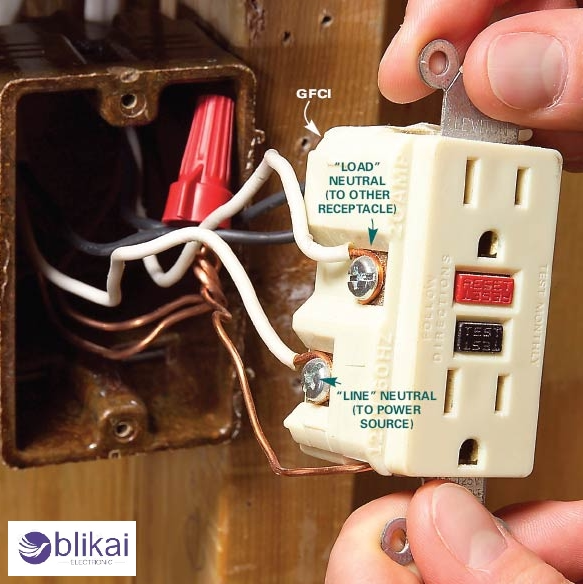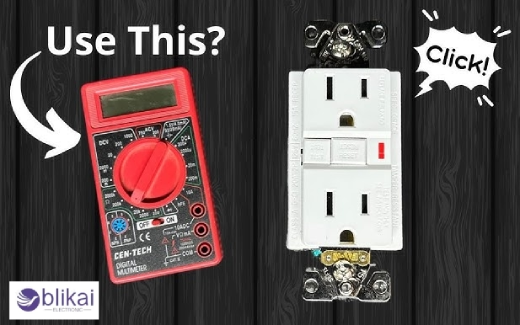Why Ground Fault Circuit Interrupter Keeps Tripping [Fix Guide]
Introduction
Currently, modern electrical systems depend on Ground Fault Circuit Interrupters (GFCI) to avoid shock and fire dangers. Tripping of the GFCI more than once can indicate a problem with the wiring, with the machines attached or with the device itself. We’re going to check the most typical causes for GFCI tripping and look at the safest way to identify and solve them in this article.

What Is a Ground Fault Circuit Interrupter (GFCI)?
A GFCI is an outlet that stops electrical power from getting to the electrical appliance if it sees a difference between the hot and neutral wires. Generally, electricity reaches the ground by accident using a water drop or a person’s body.
GFCIs are commonly installed in the following ways:
- Bathrooms
- Kitchens
- Laundry rooms
- Outdoor receptacles
- Garages
- Basements
Common Reasons Why a GFCI Keeps Tripping
1. Ground Fault Detected
A ground fault is the most common reason for GFCI tripping. This can occur when:
- Water or moisture is present near the outlet
- Damaged insulation exposed wires
- Faulty appliances leak current to the ground
2. Overloaded Circuit
GFCIs may trip if the circuit they serve gets overloaded. It takes place when a lot of powerful devices use the same place to plug in, overloading the site.
3. Faulty Electrical Appliances
Appliances that are old, damaged, or poorly maintained can cause GFCIs to trip. For example, a cracked heating element or frayed power cord can leak current.
4. Nuisance Tripping
In some cases, older models of GFCIs can probably switch off electric power unnecessarily. Interference from energy drawn by motors or fluorescent lights can also result in arbitrary tripping.
5. Wiring Problems
Improper wiring, such as:
- Loose connections
- Reversed polarity
- Incorrectly connected neutral wires
- can cause the GFCI to trip. Wiring issues are especially common in DIY installations.
6. Faulty or Worn-Out GFCI Outlet
GFCIs degrade over time. If the outlet is more than 10 years old or has been exposed to moisture, it may begin tripping without cause and needs replacement.
How to Diagnose the Problem
Here’s a step-by-step method to figure out why your GFCI is tripping:
Step 1: Unplug All Devices
You must start by unplugging everything connected to the GFCI outlet and the ones downstream before anything else. Lamps, chargers and power tools, along with other electrical items, are included. Unplug all tools and devices after that, and then push the RESET button on the outlet. If the outlet remains on without tripping, chances are that one of the earlier devices is to blame. When you start from the beginning, it’s easier to find what is causing the tripping.
Step 2: Reconnect Devices One at a Time
Once the outlet’s reset works without any devices, continue by connecting the devices one at a time. After you connect the device, click the RESET button and confirm if the GFCI trips. When a GFCI trips after a particular device is plugged in, it is possible that the device has a problem or the ground fault breaker is reacting to a current issue within the device. By doing it this way, specialists can easily and safely spot an affected device without the chance of other devices causing disruption.
Step 3: Inspect for Moisture
Many GFCI 0ri 4959 failures are due to moisture. Tripping these sorts of devices is more common in bathrooms, kitchens, outdoors or garages. A simple change in current can activate a GFCI if there is just a drop of moisture. If you identify water, use a cloth or fan to remove it, open the windows and doors and then test the GFCI switch again to make sure it works well. Leaks in your pipes or standing water near the wall can also cause problems.
Step 4: Use a Multimeter
If moisture isn’t the issue and unplugging does not fix it, a multimeter can be used to find hidden electrical faults. If you turn on your power supply, you can check if the GFCI outlet is receiving enough voltage. It is also possible to check for leakage or shorts by connecting the meters at the line and load terminals in the outlet. You should know some basic things about electrical measurements before using this method, so try to remain safe or have a specialist help you if you’re not sure.

Step 5: Check Wiring
Remove the box around the GFCI outlet and check its wiring connections. Be on the lookout for the following details:
- Have all the wires been pulled tightly and put into place under the screws or the push-in terminals? A loose connection can be the reason for occasional troubles.
- Does the line wireline up with the black mark, and the load wire line up with the gold mark on the outlet’s insulation? Inappropriate connection of wires may cause the GFCI to trip at all times.
- Observe the cords to find out if the insulation is missing, and if so, a wire can come into contact with another or a live outlet.
- Whether it’s a little confusing or not, it’s wise to have a licensed electrician look at your wiring.
Step 6: Call a Professional
Once you’ve completed all these steps and discover issues you can’t deal with safely or if the GFCI keeps tripping, call a licensed electrician. Trying to fix electrical systems on your own can be dangerous and professionals use the right skills and equipment to fix large problems. It is not safe to do advanced repairs unless you know exactly what you are doing.
How to Fix a GFCI That Keeps Tripping
A. Reset After Unplugging
If the GFCI resets when no devices are connected, plug in each device one at a time to identify the culprit.
B. Replace Faulty Appliances
If one gadget causes the GFCI to go off, fix or replace it right away. Inspect all visible wires, plugs and the insides of the device for any harm.
C. Distribute the Electrical Load
Don’t put too many heavy-duty appliances on one outlet. Using different circuits helps to lower the stress on the electric system.
4. Fix Wiring Issues
If you discover loose or incorrect wiring:
- Turn off the power at the breaker
- Tighten all wire connections
- Ensure hot (black), neutral (white), and ground (green or bare) wires are correctly placed
5. Replace the GFCI Outlet
If the outlet itself is faulty:
- Turn off the power at the circuit breaker
- Remove the old outlet
- Install a new GFCI outlet following the included wiring diagram
- Test the new outlet using the TEST and RESET buttons
Preventive Measures to Avoid Future Tripping
Test GFCIs Monthly
Press the TEST button to ensure it trips, and then RESET to restore power.
Keep Moisture Away
Use weatherproof covers outdoors and keep outlets dry indoors.
Inspect Wiring Regularly
Periodic inspections by a licensed electrician can prevent issues.
Use GFCI-Specific Breakers
In areas with high sensitivity needs, consider GFCI breakers for better protection.
When to Replace Your GFCI
GFCIs typically last 10-15 years, but exposure to moisture or constant tripping shortens lifespan.
Replace immediately if:
- It trips with no load
- The TEST or RESET button doesn’t work
- There are burn marks or signs of wear
Conclusion
Frequent tripping of a GFCI could suggest that something is wrong with your electrical system. After you understand the reason for the problem, you can solve it securely. Doing routine maintenance and replacing worn parts keeps your GFCI working correctly.
Frequently Asked Questions (FAQ)
How often should I test my GFCI outlet?
Hit the TEST button, followed by the RESET button, once a month on your GFCI outlets.
Can a bad appliance damage a GFCI?
If an appliance doesn’t work correctly, GFCI outlets might keep turning off and their lifespan will be reduced.
Is it safe to keep resetting a tripping GFCI?
No. Repeated tripping is a warning sign. Identify and fix the root cause before continuing to use the outlet.
Do GFCIs wear out over time?
Yes. GFCIs are no different; replace them every 10-15 years or sooner if they are defective.
Integrated circuit chip: Types, Applications, and FAQ
Microprocessor Vs Integrated Circuit: What’s the Differences?
Varistors: How Do They Safeguard Circuits?
Simple Electronic Circuits for Beginners
Phototransistor : Circuit Pinout & Principle
Watt Amplifier Circuit:Types,Principle and Applications
LM386 Audio Amplifier Circuit: Features, Applications and Datasheet
Isolator vs Circuit Breaker: What's the Differences?
What Is Circuit Protection And Why Is It Important? (Guide)
What is an Integrated Circuit (IC)? Working, and Types (Guide)










